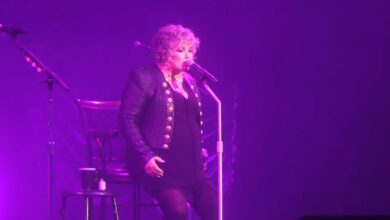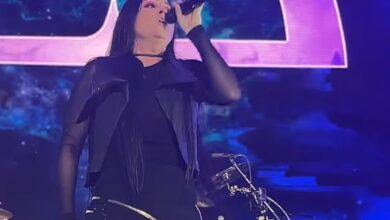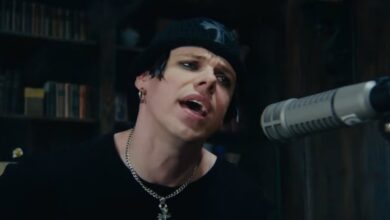When KISS Turned Dodger Stadium Into a 3-D Halloween Inferno: The Legendary 1998 “Detroit Rock City” Night
Here’s the story of how KISS turned Dodger Stadium into a roaring Halloween carnival in 1998—and why their blaze-through “Detroit Rock City” still feels like the exclamation point on one of the wildest opening nights in arena-rock history. The Psycho Circus tour launched on Oct. 31, and the choice of venue felt almost cinematic: floodlit ballpark, cool Los Angeles air, and a fanbase that showed up already dressed for the occasion. The promise wasn’t just a show; it was a stunt-filled, effects-driven spectacle that would try things rock hadn’t truly attempted at scale—especially in 3-D.
From the jump, this wasn’t a standard-issue KISS blowout. The band built the evening like a film premiere, with Halloween as their co-producer. Los Angeles had front-row seats to a “three-ring extravaganza” that folded in circus aesthetics—acrobats, motorcycle stunts, sideshow theatrics—before the main attraction detonated across the diamond. If you remember the reunion firepower of 1996–97, this was that energy running on jet fuel, wrapped in comic-book color and stadium-sized pyrotechnics that seemed to erupt from the outfield fences.
And then there were the glasses—the cardboard 3-D specs tucked into programs, posters, and even local alt-weekly promos. Fans slid them on, and elements of the staging suddenly popped: projectiles felt a little closer, the lighting rigs seemed to fold into the night sky, and the Psycho Circus iconography lurched like a funhouse mirror come to life. Plenty of arenas had tried gimmicks; KISS tried immersion. By the end of the night, those cheap lenses were souvenirs that meant something: proof you were there when a rock show briefly became a theme park ride.
The spectacle spilled past the stadium walls. FOX carved out a primetime special, billing it as the ultimate Halloween party; meanwhile, a then-ambitious corporate partner streamed the full gig online—an early glimpse of how big concerts would one day live on screens everywhere. It’s easy to forget now, but for 1998, this was forward-leaning distribution—broadcast plus a brand-backed webcast—ensuring that when the curtain dropped, millions felt the blast radius from their couches.
Even the undercard fit the night’s vibe. The Smashing Pumpkins appeared in cheeky Beatles drag—Halloween winking at rock history—and slipped in a rarity, “Cash Car Star,” en route to a jagged “X.Y.U.” medley. It set a tone: this was a costume party with real stakes, where nostalgia mingled with experiment, and where the opening act threw curveballs before KISS ever lit the first column of flame. For a few thousand fans, that combo made the whole evening feel like a documentary you were walking around inside.
When the house lights finally yielded, the set list fired like a battery of Roman candles. New-era banners snapped to “Psycho Circus,” and the familiar chant-bait of “Shout It Out Loud” put 50,000 throats to work. You could almost hear the collective grin: the makeup lineup—Paul, Gene, Peter, Ace—looked larger than life under Dodger blue. The 3-D cues synced with pyro pops, and the stadium itself felt like an instrument, a resonant chamber amplifying decades of myth.
Mid-set, they threaded needle-drops that made lifers nudge each other. “Let Me Go, Rock ’n’ Roll” revved the engine; “Shock Me” brought the Ace sizzle many had come to chase; “Calling Dr. Love” and “Firehouse” stacked the deck with classic strut. The effect was cumulative—each tune working like a chapter heading; each chorus, a toast to a shared language between band and army. For a night trading in visions, the music itself never ceded the spotlight for long.
Because it was opening night, they tucked in some gems, too. “She” and “Nothin’ to Lose” surfaced, a nod to the band’s dirtier, club-sweat DNA, the kind of selections that push a stadium show from predictable to story-worthy. You could feel the historians in the building clock it: a Halloween set that knew its own lineage and wasn’t afraid to get its hands greasy in it. In a tour built on the “new,” those two songs were the anchor points back to the original storm.
The staging flexed between comic villainy and carnival bravado. Gene’s demon theatrics, Paul’s ringmaster command, Peter’s levitating drum riser, Ace’s literal sparks—it all played like panels from a glossy graphic novel exploding across the scoreboard. The LA Times reviewer would later give a mixed verdict on the aging faces under the Kabuki paint, but even that read like a backhanded acknowledgment: the style still worked, the attitude still cracked like a whip, and in that building, on that night, the show remained the show.
Television tried to capture the lightning, but Dodger Stadium held the bottle. FOX cut in key songs, the Pepsi stream ran long, and the title cards trumpeted “The Ultimate Halloween Party.” But ambient details—the smell of fireworks drifting across the infield, the metallic shiver when the bass hit the grandstands, the 3-D flames licking at the top deck—those lived only for the ticket-holders. In an era before phones swallowed concerts, the memory stayed stubbornly analog: a sound, a flash, a roar that didn’t need a replay button.
Which brings us to the crown-swinger: “Detroit Rock City.” Slotted as a climactic encore, it arrived like a muscle car cresting the turnstiles, headlights blazing into the outfield mist. The riff is a metronome for mayhem, and in a ballpark built for crack-of-the-bat drama, it felt doubly cinematic. You could feel every seat rise in unison, decades of Friday-night bravado coalescing into a single howl. Los Angeles adopted Detroit for five glorious minutes, and the stadium itself seemed to stomp along.
The song’s street-racing narrative—speed, fate, the dangerous romance of youth—bounced off the Psycho Circus visuals in a way that felt newly literal: 3-D headlights, streaking embers, the suggestion of motion pasted across a massive screen. It was KISS’s alchemy at work: cartoon danger dressed as ritual catharsis, a chorus built to be shouted by 50,000 without losing its edge. By the time the outro burned out, you could have sworn the stadium lights flickered just from the friction.
Context matters for why this night endures. It capped a blockbuster 1990s reunion stretch and reopened the door for KISS to treat their catalog as both museum and amusement ride. The Psycho Circus gambit—first major tour to lean fully into 3-D—wasn’t just a gimmick; it was a manifesto about scale, excess, and mixing future-tech with old-school bombast. In hindsight, it foreshadowed how arena shows would chase immersion in the 2000s, from LED walls to augmented illusions.
It also functioned like a cultural handshake across generations. By pulling in a contemporary alternative titan as the opener, nodding to the Beatles in costume, and then detonating a classic-rock war chest under TV lights, the night spanned tribes. Gen X alt-kids, ’70s lifers, and new fans with face paint smudged by cotton candy all got a piece of the Halloween promise. Few bands can thread that needle without diluting themselves; KISS did it by doubling down on being KISS.
In the years since, bootlegs and broadcasts have kept the show in the bloodstream, but the afterimage changed in October 2025 when Ace Frehley—Space Ace himself—died at 74 from complications following a fall. For many, memories of Dodger Stadium now carry a softer glow: that signature bent-note snarl in “Shock Me,” the way his solos arced like bottle rockets, the sly grin under silver greasepaint. Remembering him reframes “Detroit Rock City” not just as a finale, but as a salute to the guitarist who helped hardwire KISS’s voltage into stadium concrete forever.
So when fans talk about Oct. 31, 1998, they don’t just recall tricks and treats. They talk about a band that treated a baseball cathedral like a rock cathedral, about television trying to keep up with a live show that kept sprinting, about plastic glasses turning into priceless keepsakes, about a city loving a song from another city like it was its own. Above all, they remember a night when a four-man cartoon became human again—louder than myth, sharper than memory—and, in the end, beautifully mortal.





